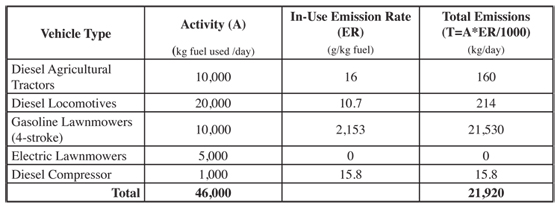Estimating Emissions from Sources of Air Pollution
6.3 Estimating Emissions from Off-Road Mobile Sources
6.3.2 A Simple Approach for Estimating Emissions
The principle of emissions prediction for off-road mobile source is similar to other categories: An emission rate for the equipment of interest is multiplied by an activity rate can provide an approximate overall emission estimate for a source. However, the activity, the population, and emission rate factors can be more challenging to determine than for other sources, since they may not be well tracked or inventoried in a region. Since many of these sources are small, it is impractical to directly measure emissions from each source. Since they are individually maintained and are not submitted to any inspection or registration program, it is often unknown how well the vehicle is operating and how often and how long it is operated.
Activity information for the first cut analysis can be obtained by a variety of sources for each off-road source category. These are usually annual and state-wide figures that are obtained from various databases. For example, the activity derived for lawn and garden equipment can be derived from surrogate data on land use, census data on residential and commercial buildings. The forestry activity may be derived from acres of forest cleared per year from the Forestry service. For airports, jet fuel sold per year may be a useful measure along with data logs of airport activities.
A selection of generic off-road emission factors are given in table 6.3.2-1 through table 6.3.2-3. All of these tables were taken from the European Union Emissions Inventory Guidebook, December 2006, B810-23. In these tables “generic” means that they do not differentiate between engine size, specific technology type, and they are approximate. These emission rates should only be used as a first order approximation. Table 6.3.2-1 presents the diesel emission factors.
The data in table 6.3.2-2 displays the 2-cycle emission factors.
Finally, the data in table 6.3.2-3 displays the 4-cycle emission factors.
Once the basic activity by source category is obtained, you can use the aggregate emission factors above and calculate the total emissions from each source as follows.
Where,
" T = total emissions (mass/time)"
" A = Activity rate as a function of technology (t) (kg fuel used/time)"
" E = emission rate as a function of technology (t) (mass/kg fuel used)"
An example of a simple inventory calculation is shown in table 6.3.2-5. The activity information is gathered in terms of amount of fuel used per time, and the emission rates are reported as in-use rates in terms of mass per unit fuel used.
Activity information for the first cut analysis can be obtained by a variety of sources for each off-road source category. These are usually annual and state-wide figures that are obtained from various databases. For example, the activity derived for lawn and garden equipment can be derived from surrogate data on land use, census data on residential and commercial buildings. The forestry activity may be derived from acres of forest cleared per year from the Forestry service. For airports, jet fuel sold per year may be a useful measure along with data logs of airport activities.
A selection of generic off-road emission factors are given in table 6.3.2-1 through table 6.3.2-3. All of these tables were taken from the European Union Emissions Inventory Guidebook, December 2006, B810-23. In these tables “generic” means that they do not differentiate between engine size, specific technology type, and they are approximate. These emission rates should only be used as a first order approximation. Table 6.3.2-1 presents the diesel emission factors.
The data in table 6.3.2-2 displays the 2-cycle emission factors.
Finally, the data in table 6.3.2-3 displays the 4-cycle emission factors.
Once the basic activity by source category is obtained, you can use the aggregate emission factors above and calculate the total emissions from each source as follows.
Where,
" T = total emissions (mass/time)"
" A = Activity rate as a function of technology (t) (kg fuel used/time)"
" E = emission rate as a function of technology (t) (mass/kg fuel used)"
An example of a simple inventory calculation is shown in table 6.3.2-5. The activity information is gathered in terms of amount of fuel used per time, and the emission rates are reported as in-use rates in terms of mass per unit fuel used.
6.3.2-5 Example of a Simple Off-Road Mobile Source Inventory Calculation for Carbon Monoxide




